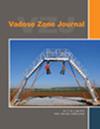Monitoring critically saturated conditions for shallow landslide occurrence using electrical resistivity tomography
IF 2.5
3区 地球科学
Q3 ENVIRONMENTAL SCIENCES
引用次数: 4
Abstract
Soil wetness is an important property in determining the variable disposition of hillslopes to shallow landslides. Recent studies have demonstrated the potential of in situ soil wetness information for landslide early warning. However, the spatial representativeness of in situ sensors may be affected by local heterogeneities of soil properties and hydrological processes, and their installation may be destructive. Electrical resistivity tomography (ERT) has been used in the past to estimate plot‐scale soil moisture variation and may overcome these limitations. In this study, we installed and operated an automated ERT monitoring system on a landslide‐prone hillslope in the Napf region (Switzerland). The system was operational during a period of 9 mo, and measurements were conducted at high temporal resolution and under different soil hydrological conditions. Electrical resistivity was measured along two perpendicular profile lines in Wenner–Schlumberger configuration at 0.25‐m electrode spacing. Soil saturation was calculated by the Archie's law and the parameters were fitted with colocated soil moisture sensors. Comparison of ERT‐derived soil moisture with soil wetness from in situ sensors showed a good correlation, and infiltration properties critical for landslide early warning could be reliably reproduced. Further, analysis of spatial saturation variation revealed that ERT was capable to detect heterogeneities of soil hydrological process. Under highly saturated conditions, the reliability of the saturation estimation was affected by an increased number of faulty measurements and the spatial heterogeneity of the infiltration process.利用电阻率层析成像技术监测浅层滑坡发生的临界饱和条件
土壤湿度是决定浅层滑坡对斜坡的可变配置的一个重要性质。近年来的研究已经证明了原位土壤湿度信息在滑坡预警中的潜力。然而,原位传感器的空间代表性可能会受到当地土壤性质和水文过程的异质性的影响,并且它们的安装可能是破坏性的。电阻率层析成像(ERT)过去已被用于估算地块尺度的土壤湿度变化,并可能克服这些局限性。在这项研究中,我们在纳夫地区(瑞士)一个滑坡易发的山坡上安装并运行了一个自动ERT监测系统。该系统运行了9个月,在高时间分辨率和不同土壤水文条件下进行了测量。在温纳-斯伦贝谢配置下,沿两条垂直剖面线测量电极间距为0.25 m时的电阻率。利用阿奇定律计算土壤饱和度,并用土壤湿度传感器拟合参数。ERT -导出的土壤湿度与原位传感器的土壤湿度比较显示出良好的相关性,并且可以可靠地再现滑坡预警关键的入渗特性。此外,空间饱和度变化分析表明,ERT能够检测土壤水文过程的异质性。在高饱和条件下,饱和估计的可靠性受到错误测量数量增加和入渗过程空间异质性的影响。
本文章由计算机程序翻译,如有差异,请以英文原文为准。
求助全文
约1分钟内获得全文
求助全文
来源期刊

Vadose Zone Journal
环境科学-环境科学
CiteScore
5.60
自引率
7.10%
发文量
61
审稿时长
3.8 months
期刊介绍:
Vadose Zone Journal is a unique publication outlet for interdisciplinary research and assessment of the vadose zone, the portion of the Critical Zone that comprises the Earth’s critical living surface down to groundwater. It is a peer-reviewed, international journal publishing reviews, original research, and special sections across a wide range of disciplines. Vadose Zone Journal reports fundamental and applied research from disciplinary and multidisciplinary investigations, including assessment and policy analyses, of the mostly unsaturated zone between the soil surface and the groundwater table. The goal is to disseminate information to facilitate science-based decision-making and sustainable management of the vadose zone. Examples of topic areas suitable for VZJ are variably saturated fluid flow, heat and solute transport in granular and fractured media, flow processes in the capillary fringe at or near the water table, water table management, regional and global climate change impacts on the vadose zone, carbon sequestration, design and performance of waste disposal facilities, long-term stewardship of contaminated sites in the vadose zone, biogeochemical transformation processes, microbial processes in shallow and deep formations, bioremediation, and the fate and transport of radionuclides, inorganic and organic chemicals, colloids, viruses, and microorganisms. Articles in VZJ also address yet-to-be-resolved issues, such as how to quantify heterogeneity of subsurface processes and properties, and how to couple physical, chemical, and biological processes across a range of spatial scales from the molecular to the global.
 求助内容:
求助内容: 应助结果提醒方式:
应助结果提醒方式:


